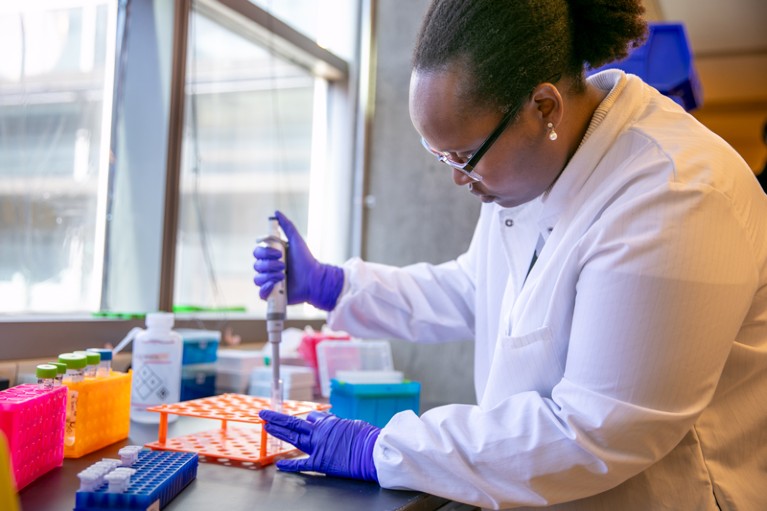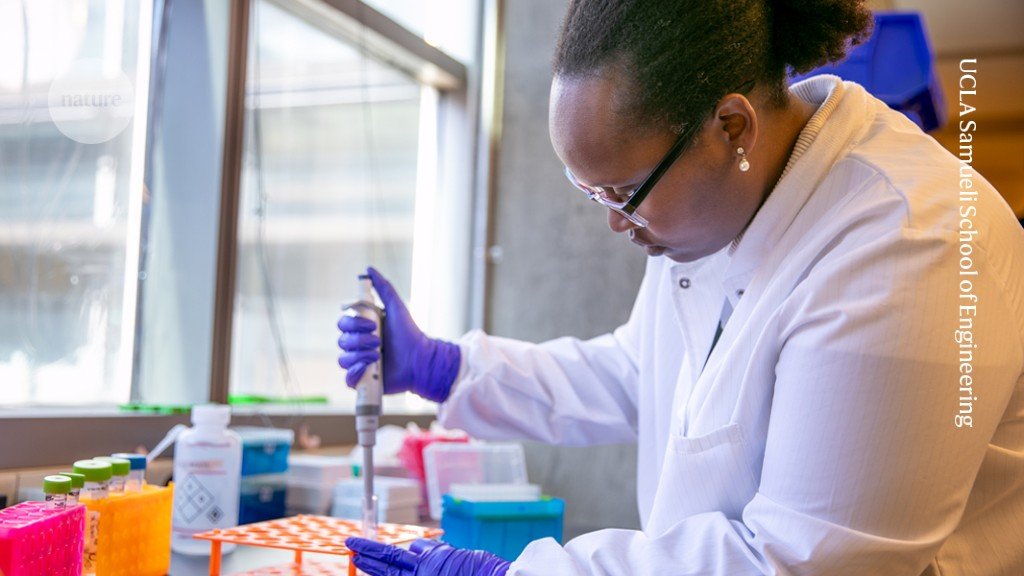
Mireille Kamariza works on an affordable test for tuberculosis, which could help to control the disease in poorer countries.Credit: UCLA Samueli School of Engineering
Inside her small office, with a window overlooking the iconic Kerckhoff Hall student centre at University of California, Los Angeles (UCLA), chemical biologist Mireille Kamariza is pursuing her big dream. Since 2015, she has steadily worked to stop transmission of deadly tuberculosis (TB) superbugs, which in 2022 infected more than 10 million people and killed more than one million.
As a PhD student working with Nobel laureate Carolyn Bertozzi, now a chemist at Stanford University in California, she developed a fluorescent diagnostic test that could be used for quick detection of TB, especially in resource-poor settings. In 2019, alongside Bertozzi, Kamariza founded the biotech start-up company OliLux Biosciences, based in Los Angeles, to develop reliable tools for detecting TB that are tailored to the complex needs of poorer countries. Nature sat down with Kamariza to talk about her progress in testing these diagnostic tools for use in the real world, and the uphill battle in fighting the spread of TB.
How did you come to focus on TB?
I grew up in Burundi, so I knew this disease called TB personally. It has infected and killed many people in my country, including a close relative. When I was 17, my parents sent me away because of the civil war that was engulfing Burundi. In 2006, I arrived in California, where I first enrolled in community college and later studied biochemistry and chemistry as an undergraduate at the University of California, San Diego.
In 2012, I joined Carolyn Bertozzi’s laboratory, then at the University of California, Berkeley, as a master’s student. Bertozzi uses chemical-biology methods to study sugars that coat the cell surface and to understand complex molecular processes in living cells. Her group found that Mycobacterium tuberculosis, the organism that causes TB, has a unique type of sugar, called trehalose, on its surface. I was fascinated by this discovery — so, for my PhD work, I aimed to find ways to use trehalose to detect Mycobacterium cells. I designed a series of trehalose sugars and tagged each of them with a fluorescent dye known as DMN. When the dye enters a cell membrane, it lights up, glowing bright green.
Did the sugars you designed work as planned?
We fed the DMN-labelled sugar to the Mycobacterium cells in Petri dishes. We discovered that when the cells take up the sugar — which only living cells can do — they turn green in one to 30 minutes, making it possible to detect and visualize TB infection. Non-TB bacterial cells and dead TB cells don’t light up, because the sugar never makes it into their membranes. Being able to distinguish living from dead cells will aid in diagnosing active TB infections, which can be spread.
It was really exciting. The speed of the test meant that doctors could rapidly detect TB in people. And the test doesn’t cost much money, so it is especially useful in resource-disadvantaged environments.
Why is it important to have TB tests designed specifically for use in poorer settings?
Today, in low-income countries, doctors depend on cumbersome, time-consuming tests to diagnose TB. One is the Ziehl–Neelsen (ZN) test, developed more than 100 years ago. The test is laborious, requires extensive processing and can give false results. There are other tests — such as TB cultures, which involve growing the bacteria in the lab — that are more reliable, but they can take weeks to produce a result. In some communities, samples must be sent to far-away labs, and it takes several weeks or months to get results. And while people are waiting, they can spread the disease in their households and communities.
How are you developing new tests for use in these communities?
In 2019, I co-founded the biotech start-up OliLux Biosciences, to take my work to the next level. My goal, both at UCLA and with the company, is to build the testing kits, prove they work and get them to hospitals in low- and middle-income countries. I don’t see academia versus industry as being an either/or choice. I chose to find a balance — I want to leverage my discoveries in the lab to make a real-world impact. In the lab, our simple, fast tests are highly effective at detecting TB. If they work in people, this could mean that whoever comes in for testing might still be in the room when they get their result. I imagine that a community health worker in rural Kenya or South Africa could carry a backpack full of our diagnostic tests. They could walk around communities, testing people and giving them their results in real time.
Are the tests being evaluated in clinical trials?
As chief executive of OliLux, I oversee strategy, partnerships and scientific production. Last December, we started our first clinical trials in Uganda, in partnership with our collaborators at the University of California, San Francisco’s Center for Tuberculosis and the international Rapid Research in Diagnostics Development for TB (R2D2) Network. We’re currently recruiting participants and working with experienced local clinicians in Uganda to evaluate our tests and whether they can be deployed in hospitals there.
What hurdles does this project face?
Setting up clinical trials for diagnostic testing in a low-resource environment is not an easy task. Collecting sputum samples — mucus collected from the lung that is used to test for TB — can be complicated and requires skilled professionals, so the R2D2 Network is helping us to do that. In rich countries, including the United States, people don’t think much about TB; the disease has been under control, thanks to antibiotics. Because it’s not prominent there, it can be difficult to attract investments from large medical-diagnostics firms. This makes securing funding a huge challenge.
What do you do to attract funding support?
I travel to conferences to give talks and meet clinicians, people with TB and researchers who care about fighting the disease. Last November, I presented at the World Conference on Lung Health in Paris, where I met lots of companies in the TB-diagnostics space. Hopefully, these meetings will lead to meaningful collaborations and access to funding opportunities. We also submit grant proposals to charities that support infectious-disease research, including the Bill & Melinda Gates Foundation in Seattle, Washington.
When might the diagnostic kits get to people in the real world?
I don’t know. It’s a long road. For example, if the clinical trials in Uganda — which might take about two years to complete — show promising results, then the diagnostic tests must pass further regulatory approvals and get endorsement from the World Health Organization (WHO). The WHO also expects quality validation studies, conducted by an independent group, to be done for any new product.
But it’s possible that we could bring TB under control. This is my calling — and I’m ready for the journey.

